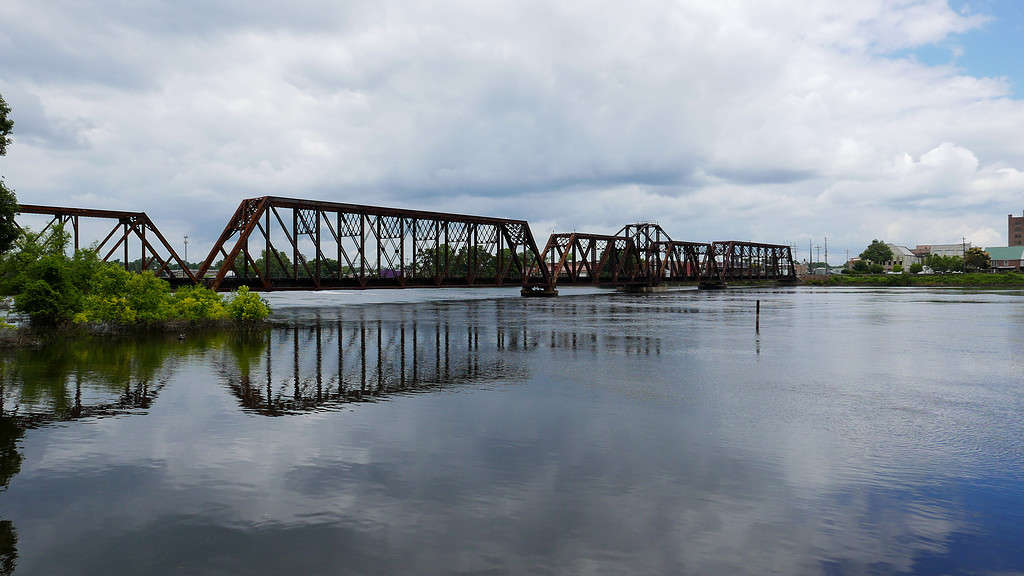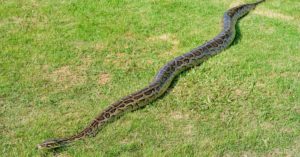One thing is certain: Louisiana waters all have alligators in them. Sometimes, those silly dinosaurs even end up in swimming pools. If you want to avoid swimming with alligators, don’t swim in Louisiana! Some bodies of water are exponentially more dangerous than others, with bayous and swamps ranking the highest. In this article, we will discuss Louisiana’s alligator-infested rivers and why the Ouachita River is an alligator haven.
The Ouachita River

There is a railroad bridge stretching across the Ouachita River in Monroe, Louisiana, that you should think twice about hopping off to visit the gators below.
©Robin Zeigler/iStock via Getty Images
The Ouachita River begins in Mena, AR, and wraps its way southeast through the Ouachita Mountains, then snakes its way through the Ouachita National Forest to Louisiana. The river’s total length is 605 miles. It crosses through 11 counties in AR and six parishes in Louisiana. Once in Louisiana, it merges with the Tensas River, forms the Black River near Jonesville, LA, and ends in the Red River approximately 35 miles north of the Mississippi and Red Rivers merging. The river is named for the Ouachita tribe, with the name derived from the Choctaw, meaning “good hunting grounds” or “hunt big.” Other tribes known to live along the Ouachita River are the Caddo, Osage Nation, Tensa, Chickasaw, and Choctaw.
The Oldest Mound is on the Ouachita River
In the beginning, long before the rise of historic tribes, their indigenous ancestors called the river’s edge home. They lived along it for thousands of years, but how long is still a mystery. Early in the Middle Archaic period, from 6,000 – 2,000 BC, the indigenous tribes constructed mounds in the Lower Mississippi Valley. These mounds were used for building hunting and gathering societies. One of the first mounds built was called Watson Brake in what is now Ouachita Parish, LA. Watson Brake is considered the oldest earthwork mound complex in North America. It is dated back 5,400 years and is significantly older than the Egyptian pyramids or Stonehenge in England. There are 11 mounds in the Watson Brake area.
Fishing and Boating on the Beautiful River
The Ouachita River is known by many to be a place for catching some fantastic and tasty local fish. Some of the most popular are the black bass, white bass, alligator gar, and freshwater drum. However, in some river areas, locals are discouraged from eating the fish they catch due to possible mercury contamination. The mercury naturally occurs near the river and in Lake Ouachita due to cinnabar, which can be seen as reddish veins on volcanic rocks in or near the water.
The river continues to attract recreational boaters due to its amazing scenery throughout Arkansas and Louisiana. It also flows into the Atchafalaya River near the Mississippi River, which is inundated with large alligators and plenty of scenic beauty in the Atchafalaya River Basin.
Alligators in the Ouachita River

The Ouachita River is the 25th longest river in the U.S.
©Robert Nunnally / CC BY 2.0 – License
While navigating any body of water in Louisiana, it’s likely that alligators are nearby. The Ouachita River is filled with alligators. So many that they even have an alligator hunting season in landlocked AR to keep the numbers in check. In fact, it’s the only state with alligator hunting that’s in a landlocked state. For two weekends annually, hunting alligators is permitted in AR by those carrying permits. Their enforced ways to kill the gators involve spearing them. This requires the hunters to get extra close to the living fossils. It’s certainly uncommon to see alligators in the mountains, though it does happen in AR!
The Upper Ouachita National Wildlife Refuge is a protected area filled with wildlife and tons of alligators! Along the banks are the protected and endangered Louisiana black bear, whitetail deer, Rafinesque’s big-eared bat, endangered red-cockaded woodpecker, bald eagles, and numerous migrating birds. This area that few humans come to helps the populations of the endangered animals rebuild in the swampland.
Near where the Ouachita River becomes known as the Black River, you will hardly be able to visit without seeing numerous alligators. Those with paddle boats sometimes report tapping the gators with their paddles as they attempt to make it through the river. This is certainly a reason to kayak faster!
The photo featured at the top of this post is © passion4nature/iStock via Getty Images
Thank you for reading! Have some feedback for us? Contact the AZ Animals editorial team.







